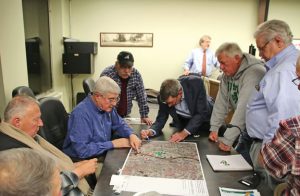
NAUGATUCK — Residents and local officials came together Monday night to discuss the future of transportation and the potential for development along the Route 8 corridor.
The Naugatuck Valley Council of Government hosted a workshop at Town Hall that drew about two dozen people. The workshop was part of the second phase of a study the NVCOG is conducting to determine how best to develop towns along Route 8 using transportation.
NVCOG Director of Planning Mark Nielsen said the study is focused on two main outcomes: what could be done in and around train stations to support an increase of transit use, and to identify alternative transportation modes in the area.
Nielsen said the area already has an incredible asset in the Waterbury branch line of the Metro North Railroad, which shuttles passengers between Waterbury and Bridgeport. The first phase of the study counted ridership and surveyed passengers on the rail line.
“The problem is it needs improvement, enhancement, and it is underutilized. But with the right investments in that infrastructure we feel there is an opportunity to see growth in the region,” Nielsen said.
Nielsen said if the state doesn’t invest in the rail line, it would have to invest in restructuring and repairing Route 8 to handle the traffic that now rides the train.
“This could be a lot more expensive and add to the congestion that is already there,” Nielsen said.
The state is planning to add new sidings and signalization along the Waterbury line to allow trains to pass each other and have more than one train on the track at once.
Mayor N. Warren “Pete” Hess said Naugatuck is poised to take advantage of an investment in the rail line with a transit-oriented development (TOD) project — a mixed-use development near a commuter station — already planned for Parcel B downtown.
“The reason for that is that we have the best TOD location in Connecticut, maybe even in New England,” Hess said. “We have entered into a contract for a mixed-use TOD project in Naugatuck, which is a significant project.”
Hess was referring to a plan to develop the roughly 5-acre vacant lot that runs alongside Old Firehouse Road known locally as Parcel B. The borough has entered into an agreement with developer Benjamin Zitron to develop Parcel B and Parcel A, the former General DataCoom building, but the project hinges on the state moving the train station from its location on Water Street to Parcel B.
“We want to rely on the rail and buses and have a major project in downtown Naugatuck that will fit in with a TOD project but even more so with our existing downtown and our beautiful architectural buildings,” Hess said. “Our existing downtown would complement this perfectly.”
Hess said the lack of frequent and reliable service on the Waterbury branch line has hindered transit-oriented development projects throughout the Naugatuck Valley.
“If you want to go work in Bridgeport, Stamford or Shelton, if you don’t make the right connection you are not going to get back. If we have frequent train service there will be great demand for this site and sites all along the railroad and throughout Connecticut,” Hess said.
The investment the state is making with the new sidings and signalization on the Waterbury line is intended to provide better service. However, when the project will be finished is anyone’s guess.
Board of Finance member Dan Sheridan said the overall plan is an ambitious one, but he was concerned about the actual schedule on the upgrades to the rail line.
“Do you have a timeline as to when some of this is going to start happening. Are we talking years, decades, centuries? This is fine, but what’s the reality,” Sheridan said.
Nielsen said one of the goals of the study is to show the state that the rail line would be worth investing in and would increase not only ridership on the line, but draw people to the state. He said the signalization along the rail line is supposed to be in place by 2019, but he didn’t have a definite answer for Sheridan as far as when the vision for development could come to fruition.
“I don’t know what the timeline is,” Nielsen said.













